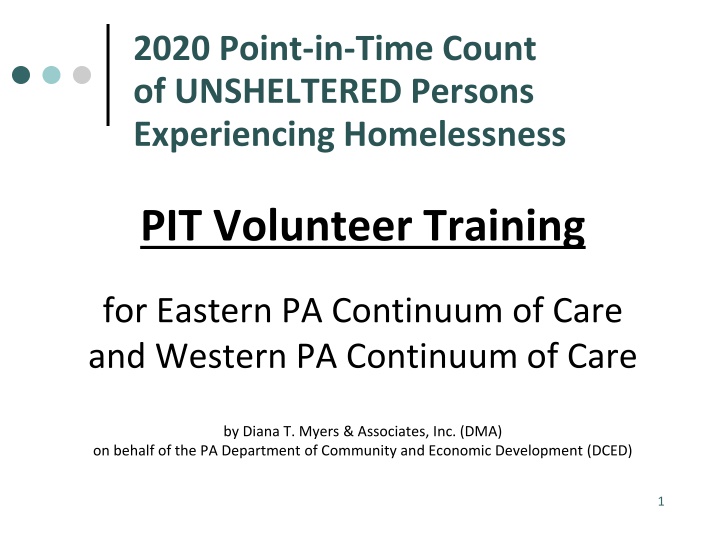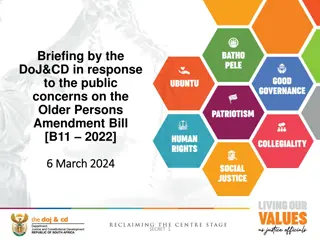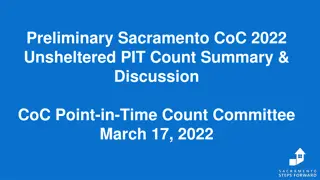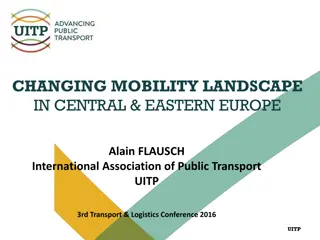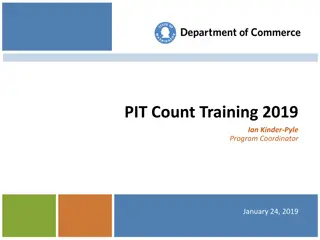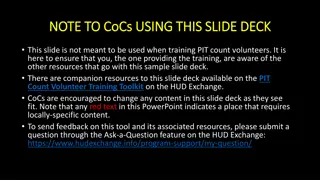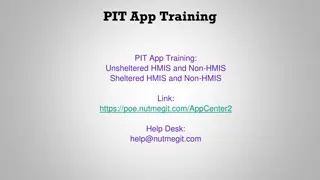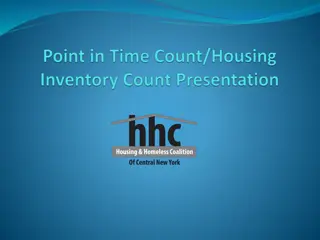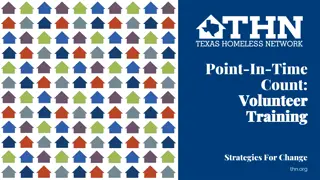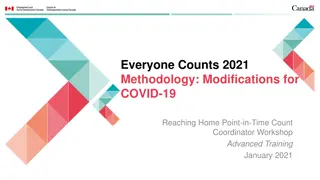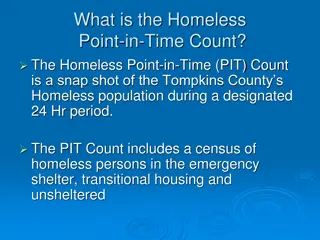2020 Point-in-Time Count of Unsheltered Persons in Eastern & Western PA Continuums of Care
The 2020 Point-in-Time Count focuses on the snapshot of individuals experiencing homelessness in unsheltered locations, aiming to obtain demographic information to measure trends and address resources effectively. Learn more about the importance and process of this count.
Download Presentation

Please find below an Image/Link to download the presentation.
The content on the website is provided AS IS for your information and personal use only. It may not be sold, licensed, or shared on other websites without obtaining consent from the author.If you encounter any issues during the download, it is possible that the publisher has removed the file from their server.
You are allowed to download the files provided on this website for personal or commercial use, subject to the condition that they are used lawfully. All files are the property of their respective owners.
The content on the website is provided AS IS for your information and personal use only. It may not be sold, licensed, or shared on other websites without obtaining consent from the author.
E N D
Presentation Transcript
2020 Point-in-Time Count of UNSHELTERED Persons Experiencing Homelessness PIT Volunteer Training for Eastern PA Continuum of Care and Western PA Continuum of Care by Diana T. Myers & Associates, Inc. (DMA) on behalf of the PA Department of Community and Economic Development (DCED) 1
Overview of Point-in-Time Count Point-in-Time (PIT) = a snapshot of the number of people experiencing homelessness on a given night Required by HUD nationally during last 10 days of January Includes people sleeping in: SHELTERED locations. This can include emergency shelters, domestic violence shelters, sometimes motels, transitional housing UNSHELTERED locations. You will count people experiencing homelessness in UNSHELTERED locations. 1) 2) 2
The Unsheltered Count: Introduction What does UNSHELTERED mean? Individuals or families whose primary nighttime residence is a public place not meant for human habitation What does COUNT mean? Obtaining basic demographic information on each person and household 3
Why do we do a PIT count? To measure and monitor trends and changes in homelessness on local and national levels To help our community understand what resources we need and strategize the best ways to use them to end homelessness To comply with federal regulations and requirements 4
The Unsheltered Count When? In our county, and throughout much of Pennsylvania, the count is conducted the fourth Wednesday night of January. 2020 PIT date = January 22, 2020 This means we are looking to identify persons experiencing homelessness during the overnight hours between Wednesday night (January 22) and Thursday morning (January 23) 5
Unsheltered Street-Based Count STREET-BASED count: Seeking out people who are sleeping outside & other unsheltered locations Examples provided on next slide May be conducted the night of Wednesday, January 22 and/or any time on Thursday, January 23 January 22: You will ask, Where will you sleep tonight? January 23: You will ask, Where did you sleep last tonight? 6
Unsheltered Street-Based Count WHERE WILL WE FIND families and individuals who are experiencing homelessness? You will be assigned to a particular area of the county where you will seek people staying in the following types of places: Truck Stops Streets Abandoned buildings Vehicles Transportation depots Parks Chicken coops Hunting cabins Railroad cars Tents Storage units Campgrounds Lumberyards Barns 7
Unsheltered Service-Based Count SERVICE-BASED count: Conducted at places providing services to persons experiencing homelessness MUST OCCUR ON January 23, 2020 You will ask, Where did you sleep lastnight? 8
Unsheltered Service-Based Count Examples of SERVICE-BASED locations include: soup kitchens food pantries health care clinics service agencies public libraries other 9
The Unsheltered Count Who? All household types should be included in the count: Families with children Couples, married and unmarried Single individuals Multi-generational Youth 10
Who is considered a Youth Household? YOUTH households may be: Parent(s) aged 24 or younger with child(ren) Single or multiple adults aged 18-24 Teenager under age 17 or child, or group of teenagers or children, who are not accompanied by an adult Use the same Interview Form for youth households, adult households, and families. 11
The Unsheltered Count What? WHAT INFORMATION are we collecting? 1. # persons in household For each person in household: Age Ethnicity Race For each adult in household: Length of time homeless # of homeless episodes Fleeing Domestic Violence (if seems safe) Disability Veteran Status 2. Gender 3. 12
The Unsheltered Count Gender Gender identity is a sensitive issue and volunteers must be non-judgmental and respectful of anyone being interviewed. Definitions included on Interview Form: TRANSGENDER: A general term used to describe people whose gender identity differs from the sex they were assigned at birth. DOESN T IDENTIFY AS MALE, FEMALE OR TRANSGENDER: Includes individuals who identify as non- binary or gender non-conforming. 13
The Unsheltered Count How? HOW WILL WE OBTAIN the information? Brief interviews preferred Complete one Interview Form for each household 1. If a household has more than five members please record additional data on a second form, clearly indicating that they are part of same household If a household includes more than one person, please ensure that data is recorded on the form consistently recording the data based on the assigned person # . e.g. If LH is person # 1 and BH is person # 2 on page 2, please ensure that BH is also person # 2 on the subsequent pages. 14
The Unsheltered Count How? HOW WILL WE OBTAIN the information? Observation - If someone will not or cannot provide the information requested on the Interview Form, complete the box on the top of page 1 based on your observation. 2. 15
Unsheltered Count: When to conduct count by observation only Individual/household is asleep/bedded down Individual/household is unwilling to be interviewed/complete the full interview, but you believe them to be experiencing homelessness. E.g. on a park bench outside in winter with all of their belongings E.g. the individual is known to you and your team 16
Unsheltered Count: When to conduct count by observation only Write down as much detail as possible that helps to make the person identifiable and to provide clues on their housing status. What is the person wearing? (e.g., black beanie, navy sweatshirt, jeans, and tan utility boots. or bundled in a grey, puffy sleeping bag that covered their face. ) What does the person look like? (e.g., shoulder-length grey hair, white, female, 50-60 years old ) Whywere you unable to complete a survey with them? (e.g., They said they did not want to complete a survey, but they were awake. ) Where did you see them? (e.g., In front of the TD bank at the corner of 6thand Cedar St. What makes you think that they are or may be experiencing homelessness? (e.g., They were sleeping on a park bench with a large bag of their belongings next to them. ) When is an observational survey NOT appropriate? I saw a man in a red sweatshirt riding by on a bike by that looked homeless. Why not appropriate? Not enough detail (age, appearance, location, details of why you believe they are experiencing homelessness) If we have more information, the unsheltered coordinator can work to make sure they were not counted by another team or an emergency shelter 17
The Interview Form: Before beginning Write your county name at the top left. Please write your name or team name/number on the top right of the form, along with the date. 18
The Interview Form Keep in mind: Individuals sleeping outside may be dealing with active addiction, mental health concerns, and significant trauma histories. Do not sneak up on or startle people. Never shine flashlights in people s faces. Maintain eye contact (if possible) and an open stance with your hands visible. Use a tone of voice that s approachable. Speak slowly, be polite, and don t shout. 19
Interviews: Introduction Hello, I am (introduce yourself by your first name). We are conducting a survey to count people experiencing homelessness in order to learn more about people experiencing homelessness, what kinds of problems they face, and to better understand what services are needed to address homelessness. Your participation is voluntary and your response to each question is voluntary. I will ask for your initials and your age, but I will not need your name, date of birth, social security number, or any other information that could be traced back to you. The responses to these questions will not be shared with anyone outside of our team. I will need to read each question all the way through. 20
The Interview Form: Consent & Screening 1. Can I have 10 minutes of your time? If no, and you believe this individual/ household is sleeping in an unsheltered location, please discontinue the survey and instead complete the observation information at the top of page 1. 2. Did another volunteer or survey worker already ask you questions about where you are sleeping tonight (or last night, depending on Wednesday/Thursday count)? If yes, please discontinue the survey. No further information is needed. 21
The Interview Form: Consent & Screening Where did you sleep last night? 3. UNSHELTERED LOCATIONS: Street / sidewalk Vehicle (car, van RV, truck) Park Bus / train station / airport Under bridge / over pass Woods or outdoor encampment Behind stores or shopping center Abandoned building Other. Specify: ________________ Households in these locations will be included in the unsheltered PIT count. SHELTERED LOCATIONS: Emergency Shelter. In a hotel/motel/rent-a-room: If yes, who paid for the room: Self / friend / family church charitable/service organization government program Don t know Other. Specify: __________________ In the home of a family member or friend PLEASE CHECK OFF, SAY THANK YOU & DISCONTINUE THE SURVEY In a home that I own/rent PLEASE CHECK OFF, SAY THANK YOU & DISCONTINUE THE SURVEY 22
The Interview Form: Consent & Screening Where did you sleep last night? SHELTERED LOCATIONS: 3. Emergency Shelter. Households in emergency shelters will be counted in the sheltered PIT count. If you transport a household to shelter, please coordinate how the information on this Interview Form will be collected, on the Unsheltered Interview Form or by the Shelter. In a hotel/motel/rent-a-room: If yes, who paid for the room? If a household is sleeping in a hotel room on 1/22/20, they should be included in the sheltered PIT count. Programs that provide hotel vouchers are included in the sheltered PIT count. If you encounter someone sleeping in a hotel on the PIT night and they have not yet completed an interview form, please complete the interview. If you provide transportation to a hotel and/or hotel vouchers during your unsheltered PIT count, please complete this Interview Form. Other. Specify: Depending on the location, this household may or may not count in the unsheltered or sheltered PIT count. XIn the home of a family member or friend PLEASE CHECK OFF, SAY THANK YOU & DISCONTINUE THE SURVEY XIn a home that I own/rent PLEASE CHECK OFF, SAY THANK YOU & DISCONTINUE THE SURVEY 23
The Interview Form: Detail In addition to checking off the appropriate unsheltered location, please also jot down any details about location. This information is used to ensure a household is not double counted. Please provide as much identifying information as possible. e.g. Blue tent behind Walmart in Pennsylvaniatown; sleeping in brown van in Flying J Truck Stop in Centralville 24
The Interview Form: Detail Ask every question. Initials only, no name Age Estimate if person does not reveal Gender ask if male, female, transgender, or does not identify as male, female, or transgender Ethnicity Hispanic/Latino or non- Hispanic/Latino Race Read list out loud and check all that apply. This list is from HUD. 25
The Interview Form Detail Questions related to the length of time homeless and number of homeless episodes. This may be difficult to recall. It is OK if you believe someone is estimating or not 100% certain about their responses. When asking about the # of times homeless in the last three years, it may be helpful to indicate that this refers to the period of time since January 2017. These questions ask about homelessness in an unsheltered situation, emergency shelter or transitional housing. It does not include sleeping in the home of a friend/family member. 26
The Interview Form: Domestic Violence If two or more adults are being interviewed together, skip the following questions: Did you need to leave the place you were last staying due to someone making you feel unsafe? Do you feel unable to return there because you feel unsafe? If yes: Would you like to speak to someone who can talk to you about increasing your safety? If yes, please provide the National DV Hotline number, as provided on the Interview Form. I have a series of additional sensitive questions to ask you. Is that ok, or do you feel like answering additional questions would compromise your safety? 27
The Interview Form: Disability READ the questions as they are written and check yes or no based on the information provided by the individual. Do not answer question based on observed behaviors. Do NOT ask follow up questions regarding the nature or severity of the person s disability. All disability-related questions should be asked of EVERY PERSON being interviewed. 28
The Interview Form: Veterans Please offer to provide each Veteran or service member with the phone number of the VA s National Call Center for Homeless Veterans, which is provided on each Interview Form. We recommend that you write the phone # down on a card such as 3x5 index card and give it to each Veteran. 29
The Interview Form: Additional Instructions Do not ask about disability, veteran status, and domestic violence of children who are in a household with their parents. If a child/teenager (under 18) is alone or only with other children, ask about disability status. 30
After the Interview Your Role Record what you heard and observed Walk away from the person interviewed to a safe place Take a few minutes after your conversation to double check that you ve completed the whole survey form Include any additional notes or details Make sure everything you have written is readable 31
Safety Considerations Number one priority is the safety of all PIT count volunteers. Please do not enter a situation that is unsafe. This may include: Building that is not structurally sound. Traveling down unpaved/ snow covered roads unless you are in a car that can handle those conditions. Approaching an individual or group of people if it does not feel safe. 32
Safety Considerations The following slides were accessed online at the Community Workspace on Homelessness (homelesshub.ca/workspace) and the Point-in-Time Count Toolkit (homelesshub.ca/pitcounttoolkit) They also have a training video online at https://www.homelesshub.ca/resource/pit-volunteer-management- training 33
Surveying Reminders Remember that you are speaking to highly vulnerable people and asking some very sensitive questions. Always lead with respect for the person you re speaking with and respect for their dignity. Everyone has the right to refuse to answer any or all of your questions. Ask all questions, unless the person has already given the answer to the question over the course of your conversation. Always ask questions as they are written; do not ask questions in a way that shows you think you already know the answer. Example: Ask: How do you identify your gender? Do not ask: You re male, right? 39
ENGAGING SURVIVORS Safety, Confidentiality, and Trauma Informed Approach
For the survivor Ask the question! Simply asking about safety will not compromise a person. Not asking could be far worse. Asking about safety in a respectful way may assist the individual in self-identification. Avoid asking about safety concerns in front of both individuals of a two adult household (as indicated in PIT survey). For the volunteer Remember that Domestic Violence/ Sexual Assault/ Human Trafficking is a targeted act against the survivor. Trust yourself if it feels unsafe, don t engage Remember that you may be the first person to hear a survivors trauma story. Make sure you have the emotional support you need.
PIT volunteers are not expected to safety plan, but if engaged, listen to the survivor and ask what they need What has worked for you to stay safe in the past? What do you need to stay safe tonight? Tomorrow? If the survivor is interested, refer to local DV program for safety planning assistance Safety planning is a process, not a one-time event or check list Safety planning is tailored to the survivor s life and daily activities each day may even be a little different
Make sure the survivor knows that all collected information from the PIT count is non-identifiable Make sure the survivor knows that you will not share their disclosure and/or story with anyone, other than submitting non-identifiable data When in doubt, ask the survivor what information they are comfortable sharing If a survivor feels uncomfortable sharing, don t press for information
Trauma: When external threat overwhelms coping resources; for survivors, this can be an ongoing state Brain becomes hyper-vigilant scanning for danger, sensing/reacting to perceived threat PTSD symptoms are seen as the behavioral manifestation of all of these changes Trauma responses are completely normal for a human being who s adapted to a traumatizing life BUT may interfere with survivors ability to enact patterns and behaviors it takes to maintain housing, which may result in survivors being unsheltered
Difficulty with emotional regulation Hyper-arousal, flashbacks, nightmares, startle reaction Memory and concentration problems Pain, sleep disturbances, illness, substance abuse issues Short attention span, easily distracted Slowed thinking, difficulty with decisions Intrusive thoughts, confusion Changed sense of self, others, and the world Loss of sense of time and space Trouble with abstract concepts, complex directions
Interact with kindness and compassion Ask questions (even uncomfortable ones) slowly and clearly Be prepared to witness any of the behaviors previously mentioned Focus on strengths if survivor needs further support If a survivor feels uncomfortable sharing, don t press for information
At the conclusion of your count Please turn all forms in to: ___Insert Name for your County________ 47
Schedule Key Contacts What to bring Q&A: What questions do you have? Logistics LOGISTICS 48
FINALLY... THANK YOU for Giving your time Caring Helping Showing up! THANK YOU FOR BEING PART OF THE 2020 UNSHELTERED PIT COUNT! 49
